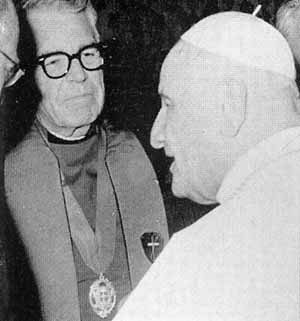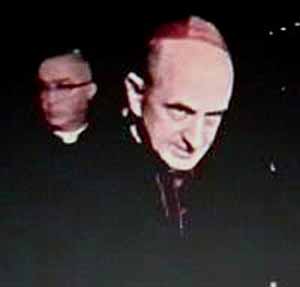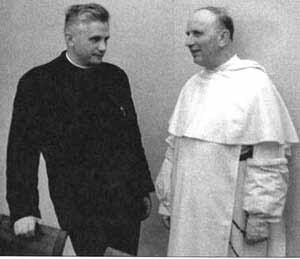 |
Book Reviews
‘Prophetic Book Reveals the Roots of the
Apocalyptic Crisis in the Church’
Frank M. Rega, S.F.O.
Book-review on In the Murky Waters of Vatican II, by Atila S. Guimarães,
(Los Angeles: Tradition in Action, 2008), 396 pp.
Reviewer's Note: June 26, 2011 - After re-reading this review which I wrote many years ago (2002), I see no reason to change the text, except for removal of the page number references to the old second edition. I recall that at the time I read the book it seemed to be quite spectacular and drastic that Guimaraes would actually consider that the Council should be declared null. I was not sure I could agree with him.
Now, ten years later, I think that not only should the Council be declared null, but also that the Roman Catholicity of the official Vatican II conciliar church itself is in question, because of its modernist, progressivist bent. This is not to reflect on individual Catholics who are loyal to the unchanging and unchangeable Tradition of the Apostolic Church, or who are sincerely trying to practice what may be the only "version" of Catholicism that they have ever known. F.R.

This book's thesis is that Vatican II launched what was intended to be a "Copernican revolution" in the Church. Instead of the laity and the local churches revolving around the ‘sun’ of the Pope and hierarchy, the "people of God" would become the new center, with priests, bishops and pope serving and answerable to the people of God and the local churches. Instead of a Church that is the perfect society (societas perfecta), and without blemish, it would become a Church in evolution, and in need of constant reform because of her imperfections, presupposing a sinful Church that must apologize for her guilt. This decentralized Church becomes hesitant in her doctrine and in her discipline.
The primary way that Vatican II initiated this revolution was by means of ambiguity, compromise, and obscurity in the conciliar documents. This opened the door to a progressivist, rather than conservative, interpretation and implementation of the documents. This conciliar ambiguity is the topic of In the Murky Waters of Vatican II, the first in a collection of 11 volumes written in Portuguese by the Brazilian Catholic intellectual Atila Sinke Guimaraes. The title given to the entire series of books is Eli, Eli, Lamma Sabacthani? In the whole collection about 900 authors are cited.
The author attempts to determine the underlying thinking of the Council. He undertakes this task by studying the principal theologians responsible for the Council and for its application, in order to determine their methods and goals. He defines the so-called spirit of the Council as "tolerance towards the world and the false religions and opposition to Catholic militancy."
After a worthwhile and lengthy series of introductory papers, the book begins with an analysis of a particular example of ambiguity from the document Lumen gentium: "This ... sole Church of Christ which in the creed we profess to be one, holy, catholic, and apostolic ... subsists in the Catholic Church". Subsists - an ambiguous term par excellence. The Church of Christ subsists in the Catholic Church, rather than is the Catholic Church; or it subsists rather than exists exclusively in the Catholic Church. "As written it implicitly affirms that there are two distinct realities – the Church of Christ and the Catholic Church – and that the latter, which is more restricted, receives its life from the former, more universal and more noble." This idea of two different churches is opposed by the traditional Catholic teaching of the Magisterium, and by the "Catholic sense of the faithful, who have always nourished themselves, as children with their mother’s milk, with the idea that the Catholic Church is the sole Church of Christ."

John XXIII launched a Copernican Revolution. In the photo, with Protestants at Vatican II |
In the third chapter, the author cites a series of texts by renowned theologians who acknowledge the ambiguity that exists in the conciliar documents. He quotes Fr. Rene Laurentin, a conciliar peritus (expert) regarding certain wordings in the documents: "they could be looked at from both sides, just like those photographic tricks whereby you see two different people in the same picture, depending on the angle you look at it. For this reason, Vatican II already has given, and will continue to give rise to many controversies." Citing an observation by Fr. Brian Harrison, "the conciliar Church issued an uncertain call about practical matters, achieving the result predicted by the Apostle Paul: ‘For if the trumpet gives an uncertain sound, who shall prepare himself to the battle?’ (1 Cor. 14:8)"
The book clearly demonstrates that Vatican II was a convergence of two currents of thought in the Church, the traditional vs. the progressivist (liberal, neo-modernist). The well-organized progressivists dominated and controlled the Council and the formulation of its documents, over the less-prepared traditionalists. Since the final versions of the Council’s documents had to be voted upon, the progressivists resorted to ambiguity as a strategy to facilitate the winning of conservative votes, and to "prevent the conservatives from waking up from their lethargy." But it also served to pave the way for a progressivist spin on interpreting the documents in the future, allowing the development of more radical positions.
The sixth chapter in the book details the clash between these two currents, and the battle over whether the Council was dogmatic or pastoral. He distinguishes seven chronological phases of this confrontation, from the preparatory period prior to the Council to the post-conciliar period. Although all phases are critical, his summary of the third phase conveys the types of interactions that prevailed:
- Alleging pastoral attitudes, the progressivists introduce into the schemata ideas of adaptation to the world and different religions.
- The conservatives protest against some of them.
- Paul VI, directly or indirectly, uses his authority to silence the conservatives, and give the victory to progressivists.
- Faced with contradictions with traditional doctrine, the conservatives accept them only by force of the pontifical authority and under the allegation that they are pastoral attitudes.
- This tactic is used until the end of the Council.
The critical seventh chapter examines the question of whether there is a hidden doctrine within the ambiguous texts. Using the writings of leading Council figures, he shows that underlying the use of ambiguity is the principle that an uncertain and hesitating theology should be normal for a Church that is evolving. Abandonment of dogmatic formulas of the past would be legitimate, "...the lack of oneness in Church teaching would be considered normal, and a corollary would be to deny authority – especially that of the pope – the competence to teach always the same thing everywhere."
Thus, the progressivists favor the concept of dogmatic teachings that can evolve and change. This implies a Church that is always reforming herself - her teaching and her liturgy. This evolving, pilgrim Church is filled with faults and imperfections, is guilty and must confess her sinfulness. This is a new conception of the Church and of the Faith, which disorients the everyday Catholic. "How can one imagine that she, one in her Faith, infallible in her extraordinary Magisterium, as well as, in certain conditions, even in her ordinary Magisterium, by the special assistance of the Holy Spirit, now shows herself to be hesitating in her dogma, unsteady in her morals, fragmented by contrasting opinions?"

Paul VI decided to do away with the militant character of the Church |
Salient omissions also lead to ambiguous conceptions of certain doctrines. The conservatives wished the Council to state clearly that Mary was a virgin before childbirth, in childbirth, and after childbirth. Instead the Council chose the formula that Our Lord "...did not diminish his mother’s virginal integrity but sanctified it (Lumen gentium, 57). Another concept that was downplayed is the doctrine of original sin. Although mentioned explicitly, a door was left open to the progressivist concept that "Adam" referred to the species of man, and that it was humanity’s sin and not the sin of an individual. There was no specific mention of Hell, allowing Council peritus Hans Kung to refer to it as "an unresolved matter." The "Roman" character of the Church was downplayed, in order to foster ecumenism, causing ambiguity as to just what is the Church of Christ. The Concept of the Church Militant, or the Missionary Church, was de-emphasized since this would interfere with overtures to other religions. The Council also refused to discuss the discipline of psychoanalysis, leaving an opening to the doctrines of Freud. Council peritus Yves Congar, who helped compose some of the Council’s final texts, is quoted in one of his books as saying that today’s man "seeks a different culture whose Fathers will be neither Athanasius nor Augustine but Marx, Freud and modern technology. The Catholic Church is abandoning her old culture, which has been her own ever since Constantine up to Vatican II."
The Council made serious concessions to other religions and to the modern world. There was a tendency to "accommodate the rite of the Mass to the doctrinal and liturgical desires of the Protestants." Confusion set in regarding the various types of presence of the Lord in the Mass - his presence in the minister, in the people of God, the Sacraments, The Eucharist, the Word, in the prayer and song of the liturgy. The priesthood of the faithful and that of the priest are confused. The Mass is desacralized and democratized. In the Offertory of the Mass: "Only an allusion to the Transubstantiation of the bread occurs, i.e.: ‘That this bread may become for us the bread of life.’ Here also we notice the presence of ambiguity since the word of God is also the bread of life." Further, the removal of the words "the Mystery of Faith (Mysterium Fidei) at the consecration of the wine contradicts previous Councils and pronouncements of the popes, and "could appear to be a deliberate attempt to eliminate the sacrificial nature of the Mass. This facilitates acceptance of the Novus Ordo by Protestants and places grave doubts about Transubstantiation in the minds of Catholic clergy and faithful."

Joseph Ratzinger and Yves Congar strongly promoted Progressivism at the Council |
Another ambiguous term in Council documents is "the world." Traditional Catholic teaching is based on the premise that the world is under original sin, and it is good only to the degree that it has been redeemed. Christ’s command was to go into the world, and preach the Gospel, teaching all nations to observe his commandments. In traditional doctrine the Church shaped the world, and her success was Christendom. But in the documents of Vatican II, the world can mean many things, including a group of men established as a society, or a temporal order such as the political structure of a nation, or sometimes it can mean simply modern civilization. This weakening and ambiguity of the term world, is reflected in the conciliar approach to it, which allows the Church to move in the direction of adapting herself and dialoging with the world as something equal, instead of teaching and converting it. "In the adaptation of the Church to the world, the Council appears implicitly to deny the divine mandate of Our Lord to the Church and to accept, also implicitly, the errors of the modern world." The consequences are the virtual destruction of Christendom, and the preaching of a messianic-religious Socialism.
The tenth and final chapter of the book deals with "other consequences" of conciliar ambiguity. A very clear picture of these consequences as they affect the every-day Catholic, was written by French Academy member Maurice Druon, and is quoted at length in this chapter. Prior to Vatican II, "never had the Church, from the simple village pastor to the pope ... benefited from a more secure situation, a more general respect, and such a prestige. Suddenly, she cracks, deteriorates, loses her roots and – one would say – is about to come crashing down on herself. Priests turn the altars around, sell church ornaments, take the saints away; prelates change their language, shut down the organs, welcome the guitars and bless the demolishers. No rite is maintained, no rule spared. The gothic arch of dogmas is cracked. The house of the Good God is opened to all storms. Bewildered, we watch this internal quake...’ This all-too-familiar description by Druon continues for almost another page.
There are other even more serious consequences. There is a crisis in the Faith and of respect for authority. Dissenting theologians listen to the pope respectfully, but continue doing as they wish, a possible consequence of the new Church centering around the people of God, whom the pope should serve. But even more importantly is the crisis in the religious orders and the clergy. Besides the obvious shortage in religious vocations there are more ominous problems. Thousands of priests are leaving the priesthood in favor of marriage, with or without permission from Rome. In 1988 reportedly there were 80,000 married priests throughout the world, with 17,000 in the United States! Even more disturbing are studies showing large numbers of priests living in concubinage or succumbing to alcoholism. The problem of homosexuality in the priesthood is treated separately in a 60-page appendix, including the vice of pedophilia. (1)
In conclusion, the author invites the reader to continue to pursue the search for the truth about Vatican II by reading the other 10 volumes in the series. At this time (May 2002) only one other volume is available in English.(2) "Therefore, taking a stance of resolute vigilance before the enemies of the Church, of compassion in the face of her sufferings and of interior peace in the certainty of victory, we invite the Reader to accompany us in the analysis of the spirit of Vatican II, of the thinking that inspired it and of the fruits that it generated." On the preceding page the author plants the seed, perhaps desperately, that the only way out might be to declare the Council null.
The works of Atila Sinke Guimaraes appear almost overnight as a looming Mount Everest. They appear on the horizon suddenly. Now that they are encountered, they must be tackled and responded to, accepted or rejected by the individual reader.
1. This appendix of In the Murky Waters of Vatican II was updated in order to cover the homosexual and pedophile scandal that came to light after. It became the book Vatican II, Homosexulaity & Pedophilia (Los Angeles: TIA, 2004, 316 pp.) available to purchase here.
2. Today the following volumes are published and available for purchase:
Vol. 2 - Animus Injuriandi I, 392 pp.;
Vol. 4 - Animus Delendi I, 502 pp.;
Vol. 5 - Animus Delendi II, 384 pp.;
Vol. 6 - Will He Find Faith? 384 pp.;
Vol. 11 - Ecclesia, 320 pp.

Posted June 30, 2011
Visit Frank Rega's website here

Read More on In the Murky Waters of Vatican II

Related Works of Interest
|
|
Book Reviews | Home | Books | CDs | Search | Contact Us | Donate

© 2002-
Tradition in Action, Inc. All Rights Reserved
|
 |

|